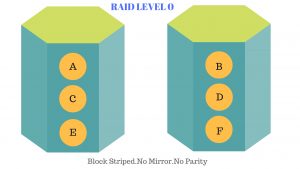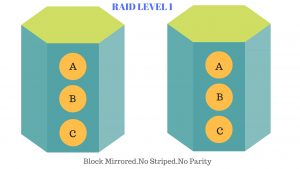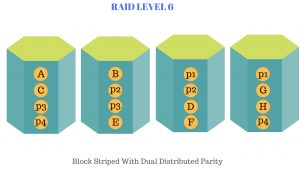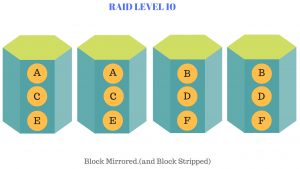Different types of RAID
RAID is short for Redundant Array of Independent Disks
RAID is a technology that is used to increase the performance and/or reliability of data storage. It combines multiple physical disk drive components into a single logical unit. Here we are discussing the the different types of RAID
Data in RAID is distributed across the drives in one of several ways, referred to as RAID levels, depending on the required level of redundancy and performance. The different schemas, or data distribution layouts, are named by the word RAID followed by a number
Different types of RAID Levels
- RAID 0 – striping
- RAID 1 – mirroring
- RAID 5 – striping with parity
- RAID 6 – striping with double parity
- RAID 10 – combining mirroring and striping
Budget Server Management Plans at $30
Note
In all the diagrams mentioned below:
A, B, C, D, E,F,G and H – represents blocks
p1, p2,p3 and p4 represents parity
RAID LEVEL 0
RAID 0 divides a set of data among multiple hard drives, usually two drives.This configuration has striping but no redundancy of data. It offers the best performance but no fault-tolerance.If one drive fails then all data in the array is lost.
Advantages
- RAID 0 offers great performance, both in read and write operations. There is no overhead caused by parity controls.
- All storage capacity is used, there is no overhead.
- The technology is easy to implement.
Disadvantages
- RAID 0 is not fault-tolerant. If one drive fails, all data in the RAID 0 array are lost. It should not be used for mission-critical systems.
Ideal Use
- RAID 0 is ideal for non-critical storage of data
- Minimum 2 disks
- Excellent performance
RAID LEVEL 1
RAID 1 stores an exact copy of your data on two or more drives. This makes your data much more secure; if one drive in the system fails, your data can simply be retrieved from any other drive in the system. This is known as data redundancy.
Advantages
- RAID 1 offers excellent read speed and a write-speed that is comparable to that of a single drive
- In case a drive fails, data do not have to be rebuilt, they just have to be copied to the replacement drive.
- RAID 1 is a very simple technology.
Disadvantages
- The main disadvantage is that the effective storage capacity is only half of the total drive capacity because all data get written twice.
- Software RAID 1 solutions do not always allow a hot swap of a failed drive. That means the failed drive can only be replaced after powering down the computer it is attached to. For servers that are used simultaneously by many people, this may not be acceptable. Such systems typically use hardware controllers that do support hot swapping.
Ideal Use
- It is suitable for small servers in which only two data drives will be used
- Minimum 2 disks
- Excellent redundancy
RAID LEVEL 5
Level 5 is one of the most popular configuration of RAID and is the most common secure RAID level. It requires at least 3 drives but can work with up to 16. Data blocks are striped across the drives and on one drive a parity checksum of all the block data is written. The parity data are not written to a fixed drive, they are spread across all drives.
Advantages
- Read data transactions are very fast while write data transactions are somewhat slower.
- If a drive fails, you still have access to all data, even while the failed drive is being replaced and the storage controller rebuilds the data on the new drive.
Disadvantages
- Drive failures have an effect on throughput, although this is still acceptable.
- This is complex technology. If one of the disks in an array using 4TB disks fails and is replaced, restoring the data (the rebuild time) may take a day or longer, depending on the load on the array and the speed of the controller. If another disk goes bad during that time, data are lost forever.
Ideal Use
- Minimum 3 disks
- RAID 5 is a good all-round system that combines efficient storage with excellent security and decent performance.
- It is ideal for file and application servers that have a limited number of data drives.
RAID LEVEL 6
Provides block-level striping with parity data distributed across all disks. It requires at least 4 drives and can withstand 2 drives dying simultaneously. The chances that two drives break down at exactly the same moment are of course very small.This technique is similar to RAID 5.If a drive in a RAID 5 systems dies and is replaced by a new drive, it takes hours to rebuild the swapped drive. If another drive dies during that time, you still lose all of your data. With RAID 6, the RAID array will even survive that second failure.
Advantages
- Like with RAID 5, read data transactions are very fast.
- If two drives fail, you still have access to all data, even while the failed drives are being replaced. So RAID 6 is more secure than RAID 5.
Disadvantages
- Write data transactions are slowed down due to the parity that has to be calculated.
- Drive failures have an effect on throughput, although this is still acceptable.
- This is complex technology. Rebuilding an array in which one drive failed can take a long time.
Ideal Use
- RAID 6 is a good all-round system that combines efficient storage with excellent security and decent performance.
RAID LEVEL 10
Combining RAID 1 and RAID 0, this level is referred to as RAID 10, which offers higher performance than RAID 1 but at a much higher cost. In RAID 1+0, the data is mirrored and the mirrors are striped.This is a hybrid RAID configuration. It provides security by mirroring all data on secondary drives while using striping across each set of drives to speed up data transfers.
Advantages
- If something goes wrong with one of the disks in a RAID 10 configuration, the rebuild time is very fast since all that is needed is copying all the data from the surviving mirror to a new drive. This can take as little as 30 minutes for drives of 1 TB.
Disadvantages
- Half of the storage capacity goes to mirroring, so compared to large RAID 5 or RAID 6 arrays, this is an expensive way to have redundancy.
Ideal Use
- Minimum 4 disks.
- Excellent performance
RAID is not a substitute to backup!
RAID improves the performance of the disk writing and data protection from disk failure except in RAID0. This doesn’t mean it can be used as a substitute to a backup solution. If a file is deleted or overwritten, we cannot retrieve it.
All RAID levels except RAID 0 offer protection from a single drive failure. A RAID 6 system even survives 2 disks dying simultaneously. For complete security, you do still need to back up the data from a RAID system.
Conclusion
From the available different types of RAID, we can be selected the one based on the number of available disks and your requirements for performance and reliability. Disk drive usage, read performance, and write performance depends on the number of drives in the array. In general, the more drives, the better the performance.
We will get maximum disk space with RAID 0, because of the striping in it. So at minimum cost, we will get maximum space. Since it doesn’t provide fault tolerance, it cannot be used for critical systems. It could never be used for databases unless you can withstand data loss or rebuild adequately from other backed-up media.
RAID 1 and 10 win on data protection but lose in terms of disk costs. RAID 10 offers the best performance and data protection but at a cost.
RAID 5 offers the best trade-off in terms of price and performance and includes data protection for database use.
NixTree offers specialized IT services including server management, cPanel Server Management , server monitoring, server support, server security services, and more for Datacenters, hosting companies, and ISPs around the world.
Talk to our experts to get the best server helpdesk support, server management service, and more.





